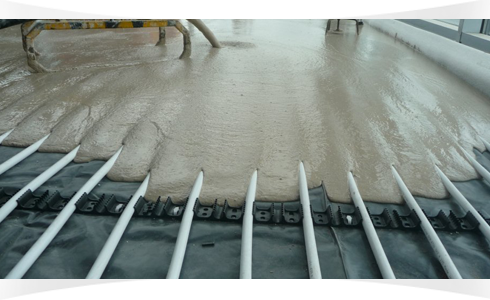



Screeding a floor is the simple act of applying a well blended mixture of ordinary cement with graded agregates and water to a floor base, in order to form a sturdy sub-floor that is capable of taking on the final floor finish or act as a final wearing surface. Nonetheless, as simple as this process might sound, there is a lot more to screeding than trowelling on the cement sand mixture. It is one of the most vital steps in flooring that plays a major role in ensuring the quality, finish and durability of the entire flooring.
With the different kind of screed types and screed constructions available, it is important to consider how well it fits in with the requirement.
Traditional screed: The standard screed mix of cement and sand mixed in the ratio of 1:3-5 is used for creating a defined layer for installing the final floor finish such as tiles, wood, linoleum, vinyl etc. Traditional screeds are generally suitable for use in hospitals, schools, hospitals, retail, homes etc.
Free flowing screeds: The anhydrite free flowing, self-leveling and self compacting screeds present the major advantage of easy placement and provide reliable results. However, the anhydrite screeds are not suitable for areas that are prone to getting wet. They cannot be used as a final wearing surface and are not compatible with cementitious products.
Floor leveling compounds: These compounds vary from the general screeds in that they are used for leveling or as the final layer of screed to increase the tolerance while laying the floor finishes such as tiles, vinyl etc. They are generally expensive and are used for screeding in warehouses and areas which require a very high level of surface regularity or flatness.
Structural Screeds: This type of screed suitable for installing on precast floor surfaces. It is important to seek accurate specifications and calculations from a structural engineer before the installation of structural screeds as the information is vital to decide on the load requirements, flexural strength, bending moment, point loadings, etc.
Fast drying floor screeds/Accelerated Screeds: If your project is on a strict time line and you do not have the time to wait for the industry benchmark of 1mm per day and 0.5mm thereafter (110 days for 75mm) for the screed to dry, it would be best to go for fast drying floor screeds like Flexi-Dry which allows you to go for the installation of the final floor finish as early as 3 days after screeding.
It is important to carry out the process of screed installation in a systematic manner to achieve the best results. Also essential are appropriate screed protection measures right after screed installation until the laying of the final floor finish in order to prevent screeding failures and in achieving a screed of high quality, finish and durability.
Getting your screed right is not difficult. But it is quite easy to get it all wrong unless carried out with attention to the minor details. And ABSTRACT’s project management and field personnel are reliable in this matter.